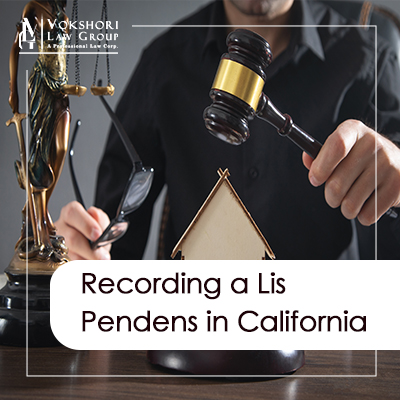
Introduction
In California, the filing of a civil lawsuit involving real estate often necessitates the recording of a lis pendens, also known as a Notice of Pendency of Action. This legal document serves as a critical tool in real estate litigation, notifying all interested parties and the public that the property in question is subject to ongoing legal proceedings. Recording a lis pendens can have significant implications for the property, so it’s essential to understand the proper protocol for its use.
What is a Lis Pendens?
A lis pendens is a written notice that a lawsuit has been filed concerning real property or an interest in real property. The term “lis pendens” is Latin for “suit pending.” When recorded with the county recorder’s office, the lis pendens becomes a public record, effectively putting the world on notice that the property’s title is subject to litigation. This can impact the property’s marketability, as prospective buyers and lenders are typically hesitant to engage with property that has a lis pendens recorded against it.
When Should a Lis Pendens Be Recorded?
In California, a lis pendens can only be recorded if there is a pending lawsuit and the underlying lawsuit affects the title to, or possession of, real property. Common examples include:
- Actions to quiet title
- Foreclosure lawsuits
- Partition actions
- Disputes involving specific performance of a real estate contract
- Cases involving fraudulent transfer of property
It is crucial that the lawsuit directly pertains to the property in question. If the lawsuit is unrelated to the property’s title or possession, recording a lis pendens could be deemed improper and subject the filer to legal consequences.
Protocol for Recording a Lis Pendens
1. Filing the Civil Lawsuit
Before a lis pendens can be recorded, a civil lawsuit must be filed in a California court. The lawsuit must specifically involve a claim affecting the title to, or right to possession of, the real property.
2. Preparing the Lis Pendens Document
The lis pendens document must be properly drafted and should include:
- The names of the parties involved in the lawsuit.
- A clear description of the real property affected by the litigation, including the property’s legal description or address.
- The case number and court where the lawsuit is filed.
- A statement indicating that the action is one in which a real property claim is made.
It is crucial that the lis pendens document is accurate and complete to avoid any challenges to its validity.
3. Serving the Lis Pendens on the Legal Owner(s)
Before recording the lis pendens, California Civil Code Section 405.22 requires that the lis pendens be served, using the last known address listed, or as shown on the latest county assessment rolls, on:
- The legal owner(s) of the property,
- Any parties whose rights might be affected by the lawsuit, such as mortgage lenders, lienholders, or other parties with a recorded interest in the property.
Service must be made by registered or certified mail, with return receipt requested. This step is essential as it ensures that all relevant parties are formally notified of the pending legal action that may affect their interests in the property.
Here’s what Section 405.22 provides:
Except in actions subject to Section 405.6, at the time of recording a notice of pendency of action, the claimant shall, by registered or certified mail, return receipt requested, direct a copy of the notice to each party to whom the real property claim is adverse and to each owner of record of the real property affected by the real property claim as shown by the latest county assessment roll. If the address of an adverse party and of an owner of record is unknown, the notice may be given by publication in the manner provided for service of summons by publication. The notice shall be directed to the addresses of the adverse parties and owners of record as shown by the records of the county assessor or by the party’s last known address.
If a party entitled to notice under this section is not in the action at the time of recording, the claimant shall, by registered or certified mail, return receipt requested, direct a copy of the notice to that party immediately upon being added as a party to the action. Proof of service shall be recorded with the notice. Service by registered or certified mail pursuant to this section is complete from the date of mailing.
The key points from the code are:
- The lis pendens must be served on each adverse party and each owner of record as per the latest county assessment roll.
- If the address is unknown, the notice can be published according to the rules for service by publication.
- If new parties are added to the action after the lis pendens is recorded, they must be served as well.
- Proof of service must be recorded along with the lis pendens.
Failure to properly serve the lis pendens before recording can render the notice invalid and subject the filer to potential legal consequences.
4. Obtaining Proper Authorization
If you are an attorney representing a party in the lawsuit, you may sign and file the lis pendens on behalf of your client. If you are a pro se litigant (representing yourself), you must obtain approval from the court before recording the lis pendens. This requirement ensures that non-attorneys do not improperly encumber property without judicial oversight.
5. Recording the Lis Pendens with the County Recorder
Once the lis pendens is prepared, properly served, and authorized, it must be recorded in the county where the property is located. The document is submitted to the county recorder’s office along with the applicable recording fees. Upon recording, the lis pendens becomes part of the public record, serving as notice to anyone interested in the property that it is the subject of litigation.
6. Serving the Recorded Lis Pendens on All Parties
After the lis pendens is recorded, a copy must be served on all parties involved in the litigation. This step is critical to ensure that all parties are formally notified of the encumbrance on the property.
The Impact of a Lis Pendens
Recording a lis pendens can significantly affect the property’s value and the owner’s ability to sell, refinance, or otherwise deal with the property. Lenders and buyers often shy away from properties with a lis pendens due to the potential complications and delays that could arise from the pending litigation.
Expunging a Lis Pendens
If the lis pendens is improperly recorded, or if the underlying lawsuit is resolved or dismissed, the party affected by the lis pendens may seek to have it expunged. Expungement removes the lis pendens from the public record, thereby clearing the property’s title. Under California Civil Code Section 405.30, the court may order the expungement if it finds that the lis pendens was not justified or that the lawsuit does not affect the property’s title or possession.
Under Section 405.38, the prevailing party in a motion to expunge lis pendens is entitled to attorneys fees.
The court shall direct that the party prevailing on any motion under this chapter be awarded the reasonable attorney’s fees and costs of making or opposing the motion unless the court finds that the other party acted with substantial justification or that other circumstances make the imposition of attorney’s fees and costs unjust. (CA Civ Code 405.38)
Conclusion
The recording of a lis pendens is a powerful tool in California real estate litigation, providing notice of pending legal actions that may affect a property’s title or possession. However, it must be used appropriately and in compliance with legal requirements. Failure to follow the proper protocol, including the crucial step of serving the legal owner before recording, can lead to significant legal and financial repercussions. If you are involved in a real estate dispute, consulting with an experienced real estate attorney can help ensure that a lis pendens is correctly handled and that your rights and interests are protected.






